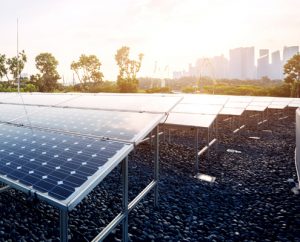50 Cities are Quietly Leading the Nation’s 100% Clean Energy Wave
September 4, 2019
It has been a good year for clean energy policy. In the first half of 2019, five states and Puerto Rico adopted laws committing to phase out fossil fuel power and transition to 100% clean energy. Those five states joined early adopters Hawaii, California, and Washington D.C. in passing such bold policies. At a critical time in addressing climate change, these policies involve binding targets for carbon-free electricity.
While several of the policies received diverse and bi-partisan support, skeptics claim that a full transition to clean energy is unrealistic. Yet about 50 California cities and counties have already achieved the bold goal of 100% carbon-free energy. Their success story has gone largely under the radar, but the achievement is nevertheless transformative and provides lessons important to reaching clean energy and greenhouse gas reduction targets.
The successful municipalities are as diverse as California, representing a variety of climate zones, income ranges, and population sizes up and down the state. Despite the diversity, there is a common thread among California’s 100% clean energy cities and counties: the vast majority are members of a community choice aggregator (CCA). CCAs enable cities and/or counties to purchase electricity on behalf of their residents and businesses. This policy tool has created an opportunity for local governments to successfully advance clean energy goals, enabling those with 100 percent renewables targets to achieve them today.
As a result, these communities and CCAs more broadly are having both direct and indirect effects on California’s total rate of renewable energy, according to a recent study by the UCLA Luskin Center for Innovation. In fact, California has already surpassed its 2020 target of 33% renewable energy, driven in large part by local demand for clean energy and progressive utilities.
Beyond California, CCAs are also supporting the acceleration of renewable energy in other states. This is a conclusion of another recent study conducted by the UCLA Luskin Center for Innovation in collaboration with the National Renewable Energy Laboratory. However, communities with high rates of renewables outside of California tend to rely more on unbundled renewable energy certificates, which have limited impact on decarbonization. Even in states without CCA enabling legislation, discussions around community choice have nevertheless led to innovative collaborations between utilities and communities wanting to receive cleaner electricity.
Across the country, more than 130 cities and 11 counties have set their own 100% clean energy targets, with several cities (in addition to the California cities listed below) achieving those targets already.
Scaling decarbonization from the local to the state and national levels will come with challenges. It will require a combination of forward-thinking policies, regulatory reforms, innovative technology, and multi-stakeholder collaboration. Increasingly, part of the solution will come from enabling locales to realize their own clean energy goals, while ensuring that they remain part of statewide energy procurement and planning efforts. As more communities overcome challenges to successfully achieve 100% clean energy, their early efforts can light the way for the rest of the country.
The UCLA Luskin Center for Innovation will host a first-of-its-kind, national Summit on Local and State Progress toward 100% Renewable and Clean Energy. This invitation-only convening on November 6th will spotlight the latest progress and insights from leaders advancing and achieving the transformative goal of 100% clean electricity. Additional analysis will come out of this summit, so stay tuned.
| 100% Renewable Cities* | 100% Carbon Free Cities** |
|---|---|
| Culver City | Agoura Hills |
| Ojai | Alhambra |
| Oxnard | Arcadia |
| Portola Valley | Beverly Hills |
| Rolling Hills Estates | Calabasas |
| Santa Monica | Camarillo |
| South Pasadena | Campbell |
| Thousand Oaks | Capitola |
| Trinity County (parts served by Trinity PUD) | Carmel |
| Unincorporated Ventura County | Carson |
| Ventura City | Claremont |
| West Hollywood | Cupertino |
| Downey | |
| Gilroy | |
| Gonzales | |
| Greenfield | |
| Hawaiian Gardens | |
| Hawthorne | |
| Hollister | |
| Los Altos | |
| Los Altos Hills | |
| Los Gatos | |
| Malibu | |
| Manhattan Beach | |
| Marina | |
| Milpitas | |
| Monte Sereno | |
| Monterey | |
| Moorpark | |
| Morgan Hill | |
| Mountain View | |
| Pacific Grove | |
| Palo Alto | |
| Paramount | |
| Redondo Beach | |
| Salinas | |
| San Juan Bautista | |
| Sand City | |
| Santa Cruz | |
| Saratoga | |
| Scotts Valley | |
| Seaside | |
| Sierra Madre | |
| Simi Valley | |
| Soledad | |
| Sunnyvale | |
| Temple City | |
| Unincorporated Los Angeles County | |
| Unincorporated Monterey County | |
| Unincorporated San Benito County | |
| Unincorporated Santa Clara County | |
| Unincorporated Santa Cruz | |
| Watsonville | |
| Whittier |
Table note: cities and counties listed above are members of one of the following electricity providers: Clean Power Alliance (CCA); Silicon Valley Clean Energy (CCA); Peninsula Clean Energy (CCA); Monterey Bay Community Power (CCA); City of Palo Alto Utilities (publicly owned utility); or Trinity Public Utilities District (publicly owned utility).
*Renewable resources include biomass and biowaste, geothermal, small hydroelectric, solar, and wind.
** Carbon free electricity includes the aforementioned renewable resources, as well as large hydroelectric.
Not all of the 100% carbon free cities are compliant with SB 100, which requires a minimum of 60% renewables.



